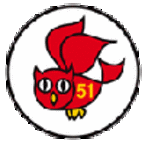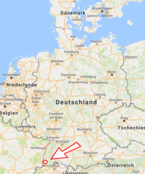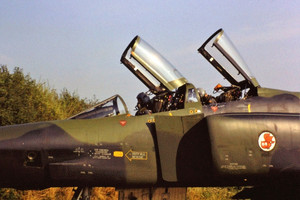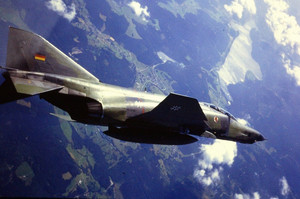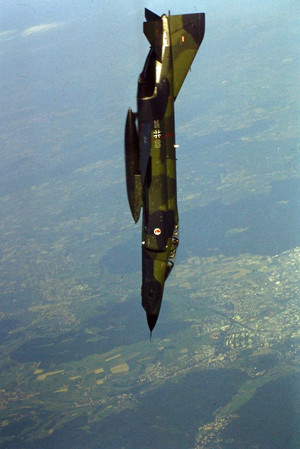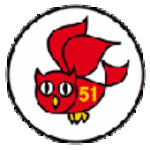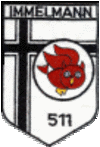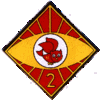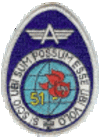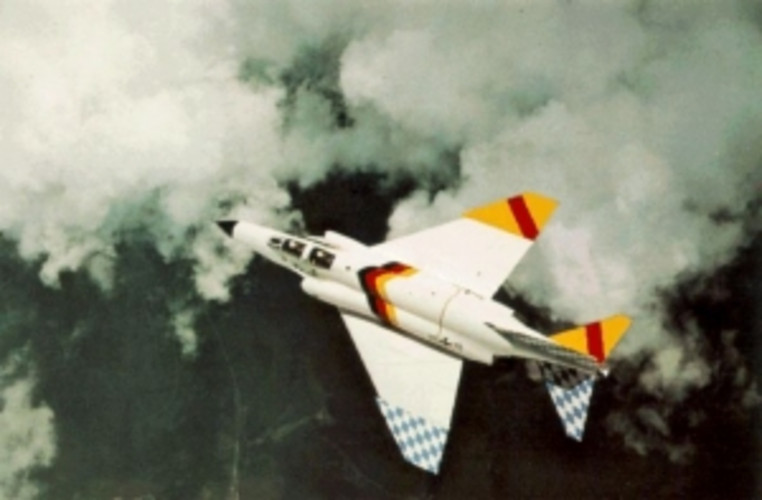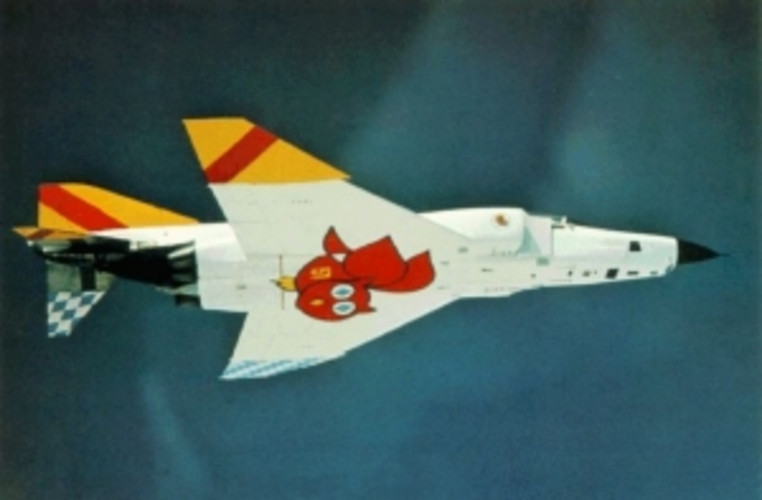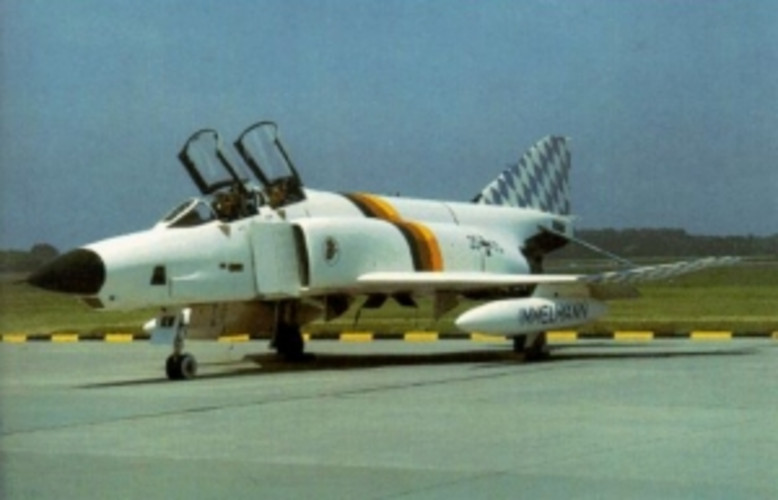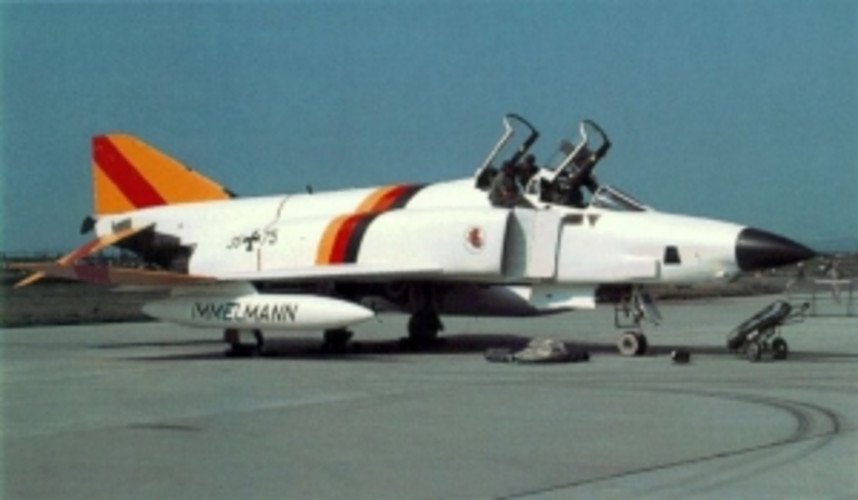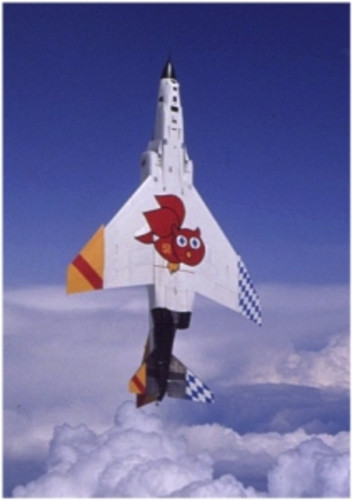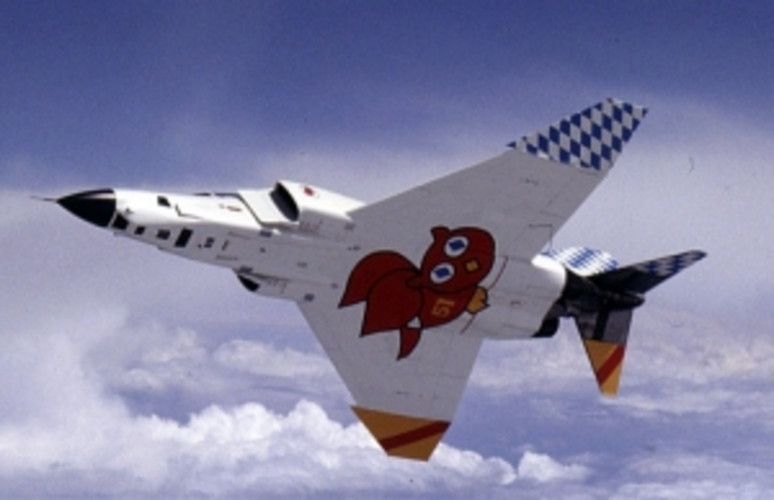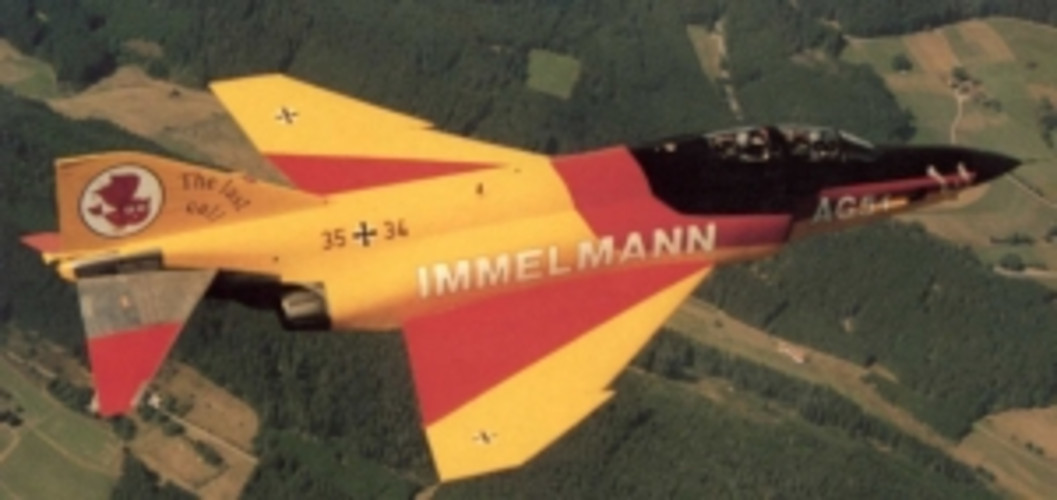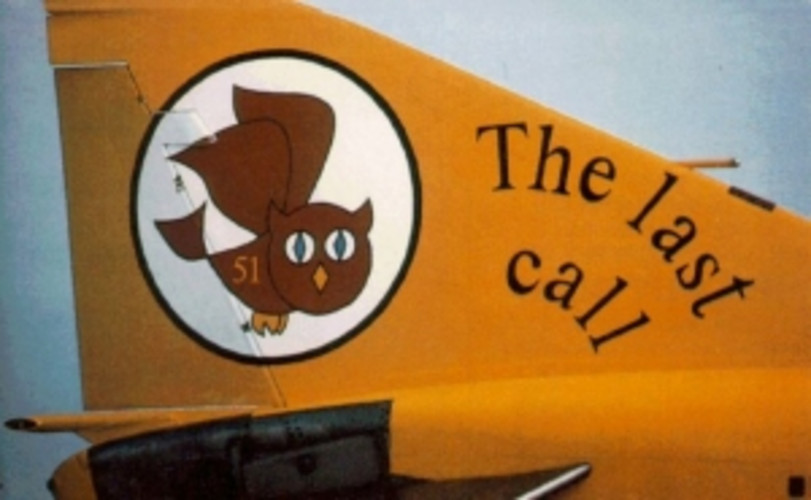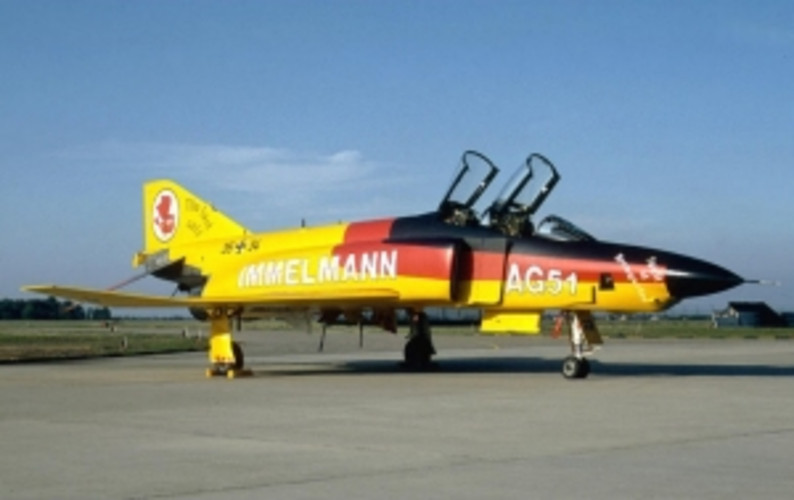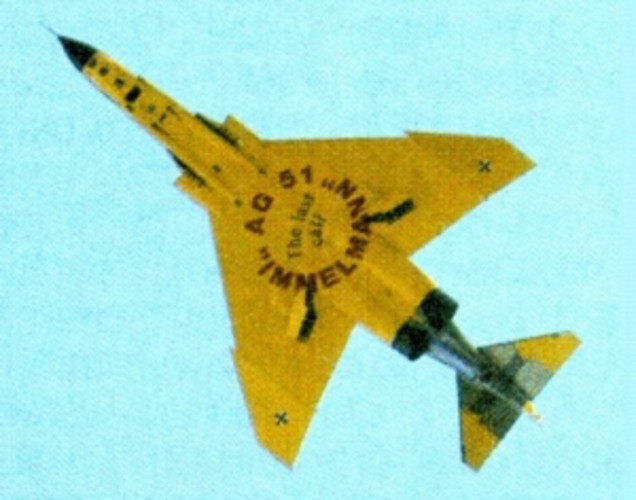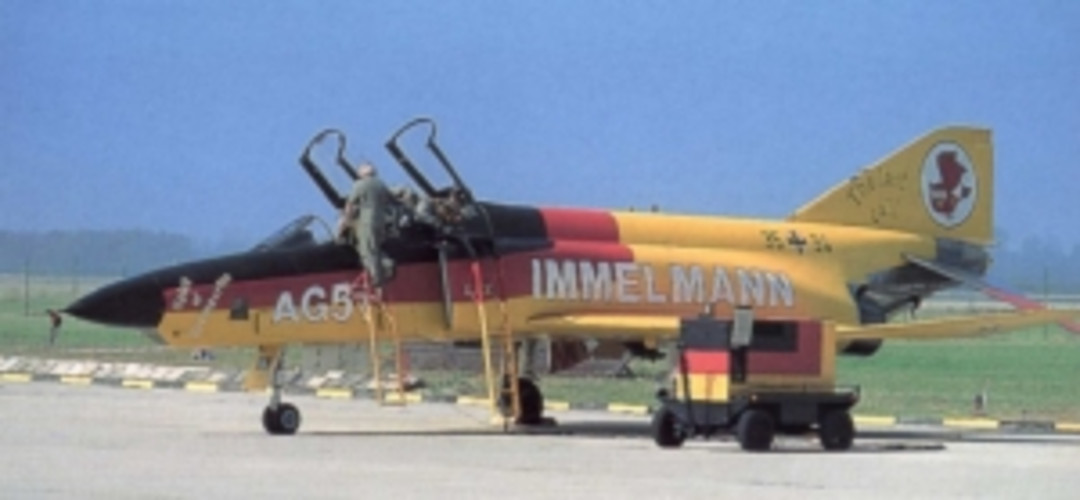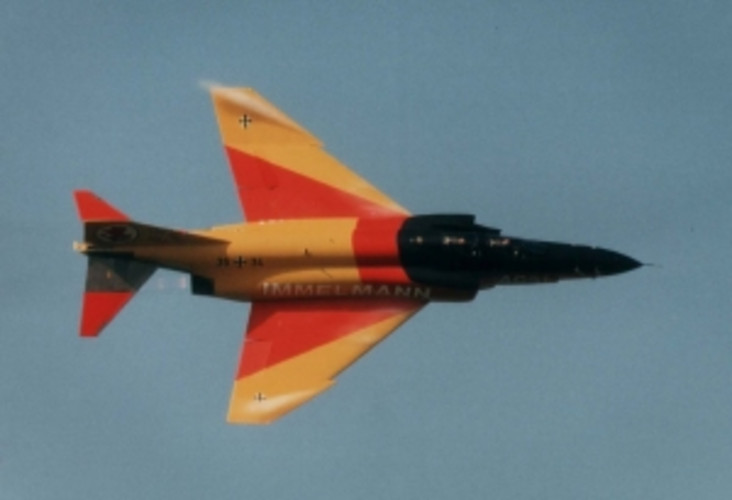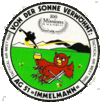RW 51 "I"
Recconaissance Wing 51 „Immelmann“
Aufklärungsgeschwader 51 (Recce Wing 51) was established on 7 July 1959 at Erding airbase. Its first commander was Colonel Walter Grasemann. The wing was equipped with 54 new RF-84 F „Thunderflash“ aircraft, which were provided by the USA as part of the Military Defense Assistance Program (MDAP). A short time later the wing moved to Ingolstadt-Manching airbase, where on 5. May 1960 it was officially put into service. The RF-84F proved to be an excellent tactical reconnaissance asset in daylight and good weather conditions but suffered from a very low thrust to weight ratio. Therefore, with warmer temperatures it was not always possible to take off with full external tanks even on an 8000 feet (ft) long runway.
On 21 April 1961 the wing was awarded the heritage name „Immelmann“ by the Luftwaffe Chief of Staff. Max Immelmann was a fighter pilot during WW I. He was awarded the Pour le Mérite for his merits and together with Oswald Boelcke he was instrumental in the development of early tactical standards and procedures. Even today an aerobatic maneuver is named after him: The „Immelmann“, a half looping with roll off at the top, thus reversing the original direction.
On 1 August 1961 the wing was assigned to NATO. At approximately the same time the Red Owl was chosen as the wing´s official emblem. On 5 December 1962 Colonel Bruno Loosen took command of the wing, which received the first RF-104 G „Starfighter “aircraft in November 1963. However, the RF-84 F continued to be flown in parallel until July 1965. Successes in NATO exercises like “Royal Flush”, squadron exchanges with NATO-partners and successful NATO tactical evaluations were contrasted by the loss of 6 RF-84 F with 3 of the pilots killed. With the new RF-104 G „Starfighter“ the pilots felt that they now belonged to NATO´s elite, but unfortunately the aircraft´s reconnaissance sensors had significant shortcomings. They consisted merely of 3 vertical optical cameras which - together with an additional 700 Pounds (lbs.) fuel tank - occupied the space made available by the removal of the Vulcan cannon. Due to the change of NATO strategy from „Massive Retaliation“ to „Flexible Response“ at the end of the Sixties the shortcomings finally became unacceptable. In addition, the so called “Starfighter Crisis” was at its peak and AG 51 “Immelmann” was not spared. 13 lost aircraft and 7 killed pilots were counted during the „Starfighter“ era of the wing, which ended in the spring of 1971 after 61.390 flying hours.
The search for a new weapons system which better suited the requirements did not last long and resulted in the RF-4 Phantom II, made by McDonnell Douglas in St. Louis/USA. First rumors concerning the acquisition of the “Phantom” spread in 1968; but before official confirmation the re-deployment of the wing to another base was initiated. France had in 1966 decided to withdraw from NATO´s military integration and gave up its bases Zweibrücken, Baden-Söllingen, Lahr, Friedrichshafen and Bremgarten in South-West Germany. The first three were taken over by the Royal Canadian Air Force, while the Luftwaffe took over Bremgarten. Bremgarten air base was built by the French occupation forces about 20 km south-west of Freiburg starting in 1951. It was a big base covering 1400 acres with a perimeter fence of 11 km length and therefore markedly different from the so called “NATO-Standard” airbases in Germany. The runway with a direction of 232°/052° (true) measured 8000 ft. in length and had a width of 148 ft. In addition, it had 50 ft. wide hardened shoulders on both sides and 1000 ft. overruns on both ends.
The parallel taxiway on the eastern side of the runway was 75 ft. wide and could have been used as a secondary runway – but never was. From this taxiway the 3 dispersal areas with 16 parking spaces each could be accessed. Airfield and barracks were not geographically separated as on the „NATO-Standard“ bases. The base had a typical French Air Force layout for a wing with 3 squadrons. In addition to the housing area there was space for 2 soccer fields, tennis courts, gym with sauna and a 25 m swimming pool. The French Air Force redeployed the resident unit EC.11 in 1967 to Toul-Rosiérs, and Bremgarten air base was handed over to Germany on 1 May 1968.
First rumors concerning the move from Manching to Bremgarten spread in the spring of 1968. On 1 April 1968 Colonel Wolfgang Sauer took command of the wing. His term as commander was dominated by the move to Bremgarten and the conversion to the RF-4 E Phantom. Already on 20 May 1968 the first elements from Manching arrived in Bremgarten. During the following years permanent construction activities were a part of daily life. When the Luftwaffe in the late Eighties finally considered how to improve the quality of life on its bases the recommended measures would have been easy to implement at Bremgarten. Due to the fact that all installations were in one place and not geographically separated, there was no need for shuttle services and the Officers- as well as the NCO mess were the places where everybody met. This facilitated a strong corporate feeling and mutual information exchange which - due to the fact that the base was located in the midst of wine-growing regions Markgräflerland, Kaiserstuhl-Tuniberg and Breisgau - sometimes took on a quite specific character.
The first three RF-104 G „Starfighter” aircraft landed on 5 March 1969 at Bremgarten, where they were welcomed by the wine-queen of Baden and their princesses. On 5 May 1969 the wing officially said farewell to its previous base Manching.
A contract covering the acquisition of 88 RF-4 E Phantom II aircraft was signed on 29 November 1968. Contrary to frequently voiced opinion the RF-4 E was not an F-4 E with a recce nose, but rather an RF-4 C with stronger J79-17 engines. On 22 October 1970 the first three RF-4 E aircraft were handed over to the Luftwaffe Chief of Staff, Lieutenant General Steinhoff, in St. Louis. The transfer of the first four aircraft (35+01, 35+02, 35+05 and 35+13) began on 16 January 1971 and led via McDill AFB and Torrejon AFB (with air refueling) to Ramstein AFB, where German nationality markings were applied. They landed on 20 January 1971 at Bremgarten, from where all RF-4E subsequently were distributed to either AG 51 „I“ or AG 52. By December 1971 all 88 German RF-4E had arrived at Bremgarten. The first RF-4E for AG 52 (35+13) was transferred and officially handed over to Leck air base on 26 August 1971.
For a time, both Recce Wings were popular destinations for all kinds of VIP groups as they flew the newest and most powerful Luftwaffe aircraft, whose impressive performance was also shown in aerial demonstrations.
At the beginning of the Seventies the middle and northern dispersal areas were provided with 11 hardened shelters each.
On 28 September 1972 Colonel Fritz Schade took command of the Wing. The Seventies were marked by successful NATO tactical evaluations (TACEVAL), by achieving 1st place in the AAFCE Royal Flush competition 1975 (Hauptmann Sowada/Major Manke), by squadron exchanges all over Europe and by the almost frictionless implementation of the Two-Man concept.
With the RF-4E, night flying evolved into a significant part of operations. Both squadrons flew weakly alternating early and late shifts. Night low level was usually flown using either the A or B night low level systems and always had a somewhat competitive character as far as target coverage was concerned.
Highlight for night operations were the „Reforger“ exercises in the early autumn of each year. The Air Force part was named “Cold Fire”. Together with USAFE RF-4Cs from Alconbury or Zweibrücken AFB and F-111s from Upper Heyford and Lakenheath AFB the German RF-4 Es were the only aircraft flying night low level in the exercise areas. This changed only when the German fighter-bomber wings received Tornado aircraft.
The introduction of the Side Looking Airborne Radar (SLAR) took place in parallel. This was the true all-weather sensor of the RF-4 E. Although the infrared sensor was usable at night also, it could not penetrate clouds. In 1979 two aircraft of each wing were assigned to NATO with SLAR. Each wing received eight SLAR modules. The system had medium and high modes, where medium amounted to 6000 – 9000 ft. and high above 35000 ft. altitude. In high mode SLAR-data could be transmitted to ground stations via data link. This required a modified centerline tank, which held only 1300 lbs. fuel instead of the usual 3900 lbs. The minimum ground speed for high mode was 480 Knots, which occasionally demanded supersonic speeds at altitude. This was not a problem for the RF-4E even with three external tanks, but fuel consumption increased considerably.
From 1979 on SLAR missions within the ADIZ (Air Defense Identification Zone – along the “Iron Curtain”) with the code name „SESAM“ were routinely flown, mainly to get early warning information about Warsaw Pact attack preparations. Crews had to be combat ready and the missions were flown in 2-ship formation for redundancy and mutual support. In clear weather conditions the inner-German border was clearly visible from 39 000 ft. and with sometimes only 5 NM distance it felt like flying over it. Sometimes, shadows accompanying the flight on the other side of the border could be seen and the radar warning receiver clearly showed the interest of the other side. Compared with flying low level, these missions - which were flown mostly on autopilot - for the aircrews were less interesting and not too popular. Altogether about 7000 SLAR missions were flown until 1992.
On 28 March 1977 Colonel Hermann Adam took over command. During his term the wing experienced a spell of bad luck. On 11 July 1977 the first RF-4 E was lost after more than six years of accident free operations. During a High-AoA-Rudder Roll the aircraft went out of control and had to be abandoned. Fortunately, the aircrew survived. Only three day later, on 14 July an RF-4 E was lost on a low level mission; this time, the aircrew lost their lives. Still another crash where the aircrew was killed happened on 11 April 1979 near the town of Erlangen. Fortunately, this was the last accident with loss of life for AG 51 „I“. Two more accidents where the crews survived happened on 18 March 1985 near Zweibrücken air base and on 6 June 1986 during low level training in the vicinity of Goose Bay air base.
On 31 March 1980 Colonel Karlheinz Koch took over command. By now an avionics update for the RF-4 E would have been called for, but the Luftwaffe was occupied introducing the Tornado and Alpha-Jet into service and financial means were therefore tied. Thus, only a half-hearted modification to allow the use as fighter-bomber in an emergency remained in the end. At least the new and significantly improved infrared sensor AN/AAD 5 was installed as part of this modification.
The additional role as fighter-bomber brought with it yearly detachments of 4 weeks duration to Beja in Portugal, which not the least for touristic reasons were quite popular. But all in all the bombing effort remained a half-hearted endeavor, which sense was not quite clear to most personnel affected by it. Anyway, in 1988 the Luftwaffe leadership decided to give up the additional role and to remove the weapons panels from the cockpit.
As Bremgarten airfield was unusually spacious it was well suited to host reinforcements from the USA as a so called Colocated Operating Base (COB). A first test of this concept was conducted with 12 F-4 E from Moody AFB in the summer of 1977. In October 1980 the first deployment of a complete squadron, the 58th TFS of the 33rd TFW from Eglin (Florida) with F-15 aircraft, took place under the designation “Coronet Eagle. 936 Sorties were planned within 24 days, however, after 21 days already over 1000 Sorties were flown. This was reason enough for a big party. The F-15 B double seaters were used extensively to provide back seat tides for AG 51 “I” aircrews, a real experience for those lucky enough! 1982 and 1984 these deployments with F-15 aircraft from Eglin AFB were repeated, but the planned F-15 deployment for 1986 from Langley AFB (Virginia) was cancelled on short notice. After that, no more deployments took place.
On 15 October 1981 Colonel Manfred Purucker took command. From now on, the low level training in Goose Bay/Labrador (GAFTIC) was a part of annual planning. After training with USAF KC-135 Tanker aircraft the first deployment of seven RF-4 E aircraft with air refueling to Goose Bay took place in the spring of 1982. GAFTIC deployments were conducted yearly until 1992, as well as deployments to Beja – the latter not for bombing, but for low level and air combat training.
On 7 July 1984 AG 51 „I“ celebrated its 25th anniversary with a big open day. The wing commander himself led a 16 ship formation as the highlight of the event. On the occasion, RF-4E 35+75 also got a special, predominantly white, paint coat.
A less pleasing topic was the implications of the Eighties´ peace movement in Germany. In conjunction with the unfavorable location close to the French nuclear power plant Fessenheim on the other side of the Rhine River, the existence of the wing was questioned in certain circles.
On 1 January 1985 Colonel Eckart Wienß took command. During his time, the wing was tasked with the development of an RF-4 E solo flight display by the leadership of the Luftwaffe. In 1987/88 the selected crew Major Großmann / Captain Stadthaus demonstrated the performance of the RF-4 E on numerous occasions. This bold initiative ended with the catastrophic mid-air of the Italian “Frecce Tricolori” aerobatic team on 28 August 1988 at Ramstein. As a consequence, German political leadership decided to take responsibility for the accident and to completely prohibit flying displays with jet aircraft. The German chancellor himself issued the verdict, although the accident involved an Italian display team at an American base at an event where German permission was not asked for due to the NATO Status of Forces agreement. Neither Italy nor the USA took even remotely similar measures.
On 25 March 1988 Colonel Gerhard Back took command. Finally, the higher echelons had recognized the need to modernize the RF-4 E after almost 20 years of service. In summer of1987 plans for a thorough modernization of avionic and sensors were launched, to which experts from AG 51 “I” contributed their experience. Based on this, it was planned to install a Laser-INS navigation system, a wide angle Head up Display (HuD) together with a one-piece windscreen and a Forward Looking Infrared (FLIR). The original cameras were to be replaced by Zeiss KS-153 cameras specifically suited for high speed low level photographs and the rear cockpit was to get a TV-Tab to enable inflight exploitation of the infrared sensor. In conjunction with the so called Recce-Attack-Interface concept, the results were to be forwarded to fighter bombers via an Operational Data Interface (ODIN). For self-defense, IR-missiles were to be carried.
Already initiated was the procurement of the digital radar AN/APQ 172 and digital radar altimeter AN/APQ 232 CARA. Both were tested with excellent results on RF-4 E 35+73. In addition, a total renewal of the ground exploitation architecture was planned.
Unfortunately, even before the inner-German wall fell, the program was abandoned in July 1989 because it was felt that the money would be needed for developmental problems with the “Jäger 90” (later “Eurofighter”).
On 31 May 1990 Colonel Uwe Focke took command. By then, considerable unease was felt concerning the future of the wing. Despite reassuring words by the leadership rumors spread and disturbing information was leaked. In spite of this Colonel Focke succeeded in keeping everybody motivated and to lead the wing through three more GAFTIC and Beja deployments up to the end of regular flying operations on 22 December 1992.
One of the last highlights was the participation in „Recce Air Meet 1990“ with 48 personnel and four RF-4 E aircraft at Bergstrom AFB/ Texas. The aircraft crossed the Atlantic with air refueling and landed after a flight time of 10:10 hrs. at Shaw (South Carolina) as intermediate stop. At that point it was the longest flight of any German fighter aircraft. Although the German crews did their best „Recce Air Meet 1990“ proved convincingly, that by then the original avionics were outdated compared to the modern digital equipment of USAF and Air National Guard aircraft.
Even a last TAC EVAL was demanded from 15 to 18 January 1991 – coinciding with the beginning of Desert Storm. The wing commander´s objection, that his task was disbandment of AG 51 „I“ and not tactical air reconnaissance any more, did not help.
On 22. May 1992 the 2. Squadron was closed, after that all operations were conducted from the 1st Sqn. facilities. The whole year saw a continued decline in personnel and material strength.
On 17 September 1992 Aufklärungsgeschwader 51 „Immelmann“ said „Good Bye“ with a „Last Call Immelmann“. 44 guest aircraft had arrived, among them Suchoi 17s from the CSSR and Hungary. Both nations where until shortly before members of the then dissolved Warsaw Pact and it took some effort to facilitate this first visit without English speaking pilots, compatible transponders or radios. The wing itself painted RF-4 E 35+34 in the yellow and red colors of the Baden region and this aircraft flying alone as well as leading a four-ship formation was displayed in the air. Starting at 10:00 p.m. a spectacular firework initiated the end of the somewhat melancholical event.
A week later, on 25 September 1992 the wing was dismissed out of its NATO assignment with a festive ceremony. On this occasion the specially painted 35+34 RF-4 E flew for the last time.
The last flights were planned for 23 December 1992. But the weather god showed mercy and prevented this with the famous Bremgarten fog. Thus, nobody could be tempted to do something he might have regretted later on.
On 16 February 1993 the last RF-4 E was ferry flown to AG 52 at Leck.
On 17. March 1993 Aufklärungsgeschwader 51 „Immelmann“ was decommissioned with a festive military ceremony. It´s successor was the „new“ Aufklärungsgeschwader 51 „Immelmann“ at Schleswig with Tornado aircraft – albeit not with the AG 51 „I“ Owl but with the AG 52 Panther as its emblem.
Original German Text by Axel Grossman
Pictures and Translation by Jürgen Erbeck



